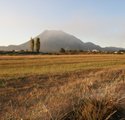|
Search
|
Most Popular

Putauaki, in the Bay of Plenty, (pictured above), became Mt. Edgecumbe after the Sergeant of the Marines on the Endeavour.

Mt Taranaki (pictured above) became known as Mt. Egmont (after John Percival, 2nd Earl of Egmont).

Te Upoko o Te Kuri a Paoa – Young Nicks Head
Following the arrival of James Cook in 1769, Maori life changed. In his voyages to New Zealand he named many of the places that he “discovered” after prominent members of the Admiralty or British aristocracy. Aoraki (The Cloud Piercer) became Mt, Cook, Taranaki became Mt. Egmont (after John Percival, 2nd Earl of Egmont), Putauaki (in the Bay of Plenty) became Mt. Edgecumbe after the Sergeant of the Marines on the Endeavour, and Whakaari became White Island, and so on.
Not only Mountains, but rivers and parts of the coastline were named also. In Cook’s very first sighting of New Zealand, Te Upoko o Te Kuri a Paoa became Young Nick’s Head (after Nick Young the cabin boy who made the sighting). His eventual departure turned Onetana into Cape Farewell. The confluence of the Waihou and Kauaeranga rivers became the Firth of Thames.
Settlements also came in for renaming. Turanganui became Gisborne (after William Gisborne, the Colonial Secretary), and Turanganui-a-Kiwa (The stopping-place of Kiwa) became Poverty Bay, because of Cook's own abysmal experiences there where his marines killed local Maori engaged in a ceremonial challenge.
Almost all of these names introduced by Cook and those that followed him are still with in use today, although there is a concerted effort by Maori to reinstate the Maori place names. This is hardly surprising. Maori traditionally identify themselves not as individuals, but as members of a set of relations which includes not only human relatives, but also places and landmarks that are viewed as ancestors.
Hence, an individual will begin a formal introduction by first naming their mountain, then their river, then their tribe, their hapu, and so on. In pre-European times Maori land tenure was in a continual state of flux, as tribes moved to occupy more fertile territories and so on. One of the ways in which manawhenua (authority or custodianship or historical use rights) over territory was to ensure that occupation was maintained in the collective memory of the people. Hence to identify oneself through a place was to ensure a continuing and collective relationship to that place no matter what else transpired.
In addition to issues of identity, there were also issues of utu (reciprocal responsibilities, debts and/or retributions to consider. One of the reasons Maori formal greeting ceremonies are so drawn out is because in the highly charged and violent world of Iwi confrontation, it was fatally important to know who visiting strangers were, and what their historic relationship to the host tribe might be. A perceived injustice from several generations past might still be the fuel for a conflict in the present. Hence, an extended description of whakapapa (genealogy) taking into account descriptions of geographical location became a crucial marker to inter-tribal histories.
Finally, Maori place names, like the Turanganui-a-kiwa already mentioned, are almost always descriptions of historic events – in this case, the stopping or resting of Kiwa at this place. The four main tribal groups of the region, (Te Aitanga-a-Mahaki, Rongowhakaata, Ngai Ta manuhiri and Te Aitanga-a-Hauiti) have a common ancestor, Kiwa, who landed here and discovered the area. (In much the same way that Young Nick’s head was named by Cook).The Maori name therefore stands as a reminder not only of the history of who came here first, but of a bond of common ancestry between proximate peoples, allowing for extensions of trade and goodwill between them.
The importance of Maori place names to Maori identity, Maori history, Maori social relations and Maori political relations is therefore paramount. The use of these Maori names will help establish and support a collective understanding and remembering among non-Maori of the importance of celebrating our differences.
A good place top start is: The Reed Dictionary of Maori Place Names, A. W. Reed, Wellington, 1999.

